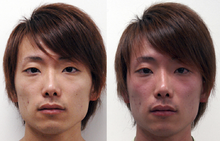| Disulfiram-alcohol reaction (DAR) | |
|---|---|
| Other names | Disulfiram ethanol reaction (DER), Antabuse effect, acetaldehyde syndrome |
 | |
| Alcohol flush reaction is a visible effect of DAR. | |
| Specialty | Toxicology |
| Symptoms | Flush, nausea, lightheadedness, headache, sweating, vomiting, vertigo, etc |
| Causes | Ingestion of disulfiram with alcohol |
Disulfiram-alcohol reaction (DAR) is the effect of the interaction in the human body of alcohol drunk with disulfiram or some mushrooms.[1][2] The DAR is key to disulfiram therapy that is widely used for alcohol-aversive treatment and management of other addictions (e.g. cocaine[3][4] use).[5][6] Once disulfiram-treated patients take alcohol, even in small doses, they experience strong unpleasant sensations (flush, nausea, lightheadedness, headache, sweating, vomiting, and vertigo).[7]
Disulfiram has been used to treat alcoholism since 1948 after its accidental discovery in Denmark.[8][9][10]
- ^ Elenbaas, R. M. (August 1977). "Drug therapy reviews: management of the disulfiram-alcohol reaction". American Journal of Hospital Pharmacy. 34 (8): 827–831. PMID 331944.
- ^ Johansson, Benny; Angelo, Helle R.; Christensen, Jens Knud; Møller, Ib Walther; Rønsted, Per (March 1991). "Dose-Effect Relationship of Disulfiram in Human Volunteers. II: A Study of the Relation between the Disulfiram-Alcohol Reaction and Plasma Concentrations of Acetaldehyde, Diethyldithiocarbamic Acid Methyl Ester, and Erythrocyte Aldehyde Dehydrogenase Activity". Pharmacology & Toxicology. 68 (3): 166–170. doi:10.1111/j.1600-0773.1991.tb01216.x. PMID 1647526.
- ^ Barth, Kelly S.; Malcolm, Robert J. (2010). "Disulfiram: An Old Therapeutic with New Applications". CNS & Neurological Disorders Drug Targets. 9 (1): 5–12. doi:10.2174/187152710790966678. PMID 20201810.
- ^ O'Shea, Brian (December 2000). "Disulfiram revisited". Hospital Medicine. 61 (12): 849–851. doi:10.12968/hosp.2000.61.12.1483. PMID 11211585.
- ^ Beyeter, Christine; Fisch, Hans-Ulrich; Preisig, Rudotf (March 1985). "The Disulfiram-Alcohol Reaction: Factors Determining and Potential Tests Predicting Severity". Alcoholism: Clinical and Experimental Research. 9 (2): 118–124. doi:10.1111/j.1530-0277.1985.tb05531.x. PMID 3890590.
- ^ Tayyareci, Yelda; Acarel, Esra (January 2009). "Acute myocardial infarction associated with disulfiram-alcohol interaction in a young man with normal coronary arteries". Turk Kardiyoloji Dernegi Arsivi. 37 (1): 48–50. PMID 19225254.
- ^ Amuchastegui, Tomas; Amuchastegui, Marcos; Donohue, Thomas (February 2014). "Disulfiram--alcohol reaction mimicking an acute coronary syndrome". Connecticut Medicine. 78 (2): 81–84. PMID 24741856.
- ^ Murthy, K. Krishna; Praveenlal, K. (July 1988). "An Experience with Disulfiram in the management of Alcohol Dependence Syndrome". Indian Journal of Psychological Medicine. 11 (2): 145–148. doi:10.1177/0975156419880213. S2CID 220676012.
- ^ Altun, Gurcan; Altun, Armagan; Erdogan, Okan (October 2006). "Acute Myocardial Infarction Due to Disulfiram (Antabus)–Alcohol Interaction". Cardiovascular Drugs and Therapy. 20 (5): 391–392. doi:10.1007/s10557-006-0493-8. PMID 17119876. S2CID 30117045. ProQuest 213848944.
- ^ Glatt, M. M. (April 1959). "Disulfiram and Citrated Calcium Carbimide in the Treatment of Alcoholism". Journal of Mental Science. 105 (439): 476–481. doi:10.1192/bjp.105.439.476. PMID 13665310.